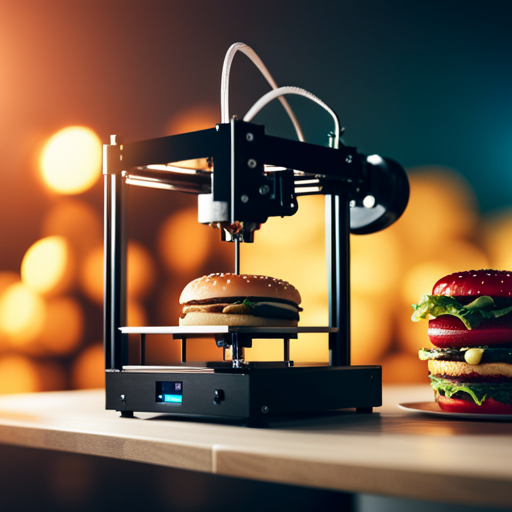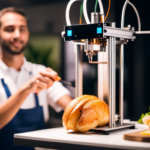Curious about the intersection of food and 3D printing?
Discover the fascinating world of intellectual property in food 3D printing. From copyright considerations to patents and trademarks, this article delves into the essential knowledge you need to navigate this innovative space.
Gain insights into enforcement and compliance, and uncover the key principles that will shape the future of food 3D printing.
Understanding Food 3D Printing Basics
Understanding the basics of food 3D printing involves grasping the intricacies of additive manufacturing technology and its application in the culinary realm. This innovative technology allows for the creation of edible designs by layering materials such as chocolate, sugar, or dough, based on digital models.
Food safety is a critical consideration in 3D food printing, as it directly impacts consumer health. Ingredients must be carefully selected, and strict hygiene standards maintained throughout the printing process to ensure the end product is safe for consumption.
Culinary creativity is a key driver of 3D food printing, enabling chefs and food innovators to push the boundaries of traditional food presentation and design. It offers a new platform for artistic expression, allowing for the production of intricate and visually stunning food creations that were previously impossible to achieve using traditional methods.
Ultimately, understanding the fundamentals of food 3D printing sets the stage for exploring its potential applications and implications in various culinary settings, from high-end restaurants to large-scale food production facilities.
Copyright Considerations in Food 3D Printing
When delving into the realm of food 3D printing, it is essential to consider the copyright implications associated with the creation and reproduction of edible designs. Copyright considerations in food 3D printing are crucial to avoid potential legal implications such as copyright infringement.
In the context of food 3D printing, copyright issues can arise when replicating designs that are protected by copyright law. It’s important to recognize that copyright law protects original creative works, including artistic designs, logos, and other visual elements that may be incorporated into food designs. Therefore, individuals and businesses involved in food 3D printing must be mindful of potential copyright infringement when creating and reproducing edible designs.
To mitigate the risk of copyright infringement, it is advisable to seek permission from the copyright holders before reproducing any copyrighted designs in the context of food 3D printing. Additionally, understanding the legal implications of copyright law in the realm of food 3D printing can help businesses and individuals navigate the complexities of intellectual property rights while fostering innovation within legal boundaries.
Patents and Food 3D Printing
In the context of food 3D printing, the protection of innovative processes and technologies through patents is a crucial consideration for individuals and businesses seeking to safeguard their intellectual property rights. When it comes to patents and food 3D printing, several key points should be taken into account:
-
Patent Eligibility: Determining what aspects of food 3D printing can be patented, considering the unique intersection of technology and food.
-
Patent Infringement: Understanding the risks and implications of infringing on existing patents in the field of food 3D printing.
-
Legal Challenges: Navigating the complex legal landscape surrounding patents in the context of food 3D printing, including potential disputes and litigation.
Navigating the realm of patents in food 3D printing can be intricate, as it involves protecting the technological innovations while considering the regulations and legal challenges associated with patent infringement. Understanding these aspects is essential for individuals and businesses involved in this burgeoning field.
Moving forward, it is important to also explore the significance of trademarks and branding in food 3D printing.
Trademarks and Branding in Food 3D Printing
An essential consideration in food 3D printing is consistently maintaining brand identity and trademarks to establish a strong market presence. Branding regulations play a crucial role in shaping the way food 3D printing companies present themselves to consumers. These regulations govern the use of logos, slogans, and other brand identifiers, ensuring that they adhere to legal requirements and accurately represent the company’s values and products.
In the realm of food 3D printing, marketing strategies are pivotal in creating and maintaining a distinctive brand. Companies must utilize innovative marketing techniques to effectively communicate their unique selling points and connect with their target audience. This includes establishing a strong online presence, leveraging social media platforms, and engaging in experiential marketing to showcase the novelty of 3D printed food products. Moreover, companies need to carefully strategize how they position their brand within the competitive landscape of the food industry, considering factors such as consumer preferences, market trends, and ethical considerations.
Enforcement and Compliance in Food 3D Printing
Maintaining adherence to intellectual property laws and regulatory standards is imperative for ensuring enforcement and compliance in the field of food 3D printing. Enforcement of these laws and regulations is crucial to safeguard the rights of innovators, protect consumers, and promote fair competition within the industry. Compliance with established standards also ensures the safety and quality of 3D printed food products, fostering trust and confidence among consumers.
To achieve effective enforcement and compliance in food 3D printing, the following key aspects must be considered:
-
Regulatory Oversight: Clear and comprehensive regulatory frameworks are essential to govern the production, labeling, and marketing of 3D printed food items. Regulatory bodies play a critical role in monitoring and enforcing compliance with these regulations.
-
Intellectual Property Protection: Effective enforcement of intellectual property rights, including patents and copyrights, is vital to incentivize innovation and prevent unauthorized use or reproduction of 3D printed food designs and recipes.
-
Quality Control and Testing: Implementation of stringent quality control measures and regular testing protocols is necessary to ensure that 3D printed food products meet safety, nutritional, and labeling standards.
Frequently Asked Questions
Can 3D Printing Food Alter the Nutritional Value of the Food?
3D printing food has the potential to alter its nutritional value through the choice of ingredients and production process. Ensuring food safety, sustainable production, and minimizing food waste are critical considerations in this innovative technology.
What Are the Potential Health and Safety Concerns Related to 3D Printed Food?
Food safety is a critical concern with 3D printed food. While the technology offers exciting possibilities, potential health concerns arise from the use of various printing materials and the risk of contamination. Vigilant regulation and testing are essential.
How Does 3D Printing Food Affect the Taste and Texture of the Food?
3D printing food can impact taste modification and texture analysis. The process involves layering edible materials to create intricate designs, potentially altering the sensory experience. Careful consideration of ingredient composition and printing techniques is essential.
Are There Any Environmental Implications of 3D Printing Food?
The environmental implications of 3D printing food are significant. It offers potential for environmental sustainability by reducing food waste and energy consumption. For instance, personalized portioning can minimize overproduction and subsequent waste in traditional food manufacturing processes.
What Are the Ethical Considerations of 3D Printing Food, Particularly in Terms of Food Waste and Sustainability?
When considering 3D printing food, ethical considerations around sustainability and food waste are paramount. Ensuring food safety and minimizing waste are crucial, as well as addressing cultural implications to create a responsible and sustainable approach.
Conclusion
In conclusion, the complexities of intellectual property in food 3D printing cannot be overstated. With copyright, patents, trademarks, enforcement, and compliance all playing crucial roles, it is essential for individuals and companies to navigate this landscape carefully.
Failure to do so could result in legal challenges, financial losses, and damage to brand reputation. Therefore, a thorough understanding of intellectual property laws and a proactive approach to compliance are paramount in the world of food 3D printing.


